Lawmakers would still be free to secure money for projects like building bridges or water systems, according to six people familiar with the decision who spoke on condition of anonymity.
“We want to be even clearer about not doing commemorations, not doing ‘monuments to me,’ making sure there’s absolutely no personal entanglements,” said Rep. Tom Cole (R-Okla.), the party’s No. 2 appropriator in the House.
The move is, in part, a result of Speaker Kevin McCarthy’s bargain with his Freedom Caucus detractors during the speaker’s race last month. It’s also the latest step in a longtime push to defuse the political risk behind the GOP’s overwhelming support for continuing earmarks — which were banned by Congress more than a decade ago at the behest of Tea Party activists aggrieved by member abuses of them.
Under the newest constraints, House Republicans can claim they’re cracking down on federal overreach, all while enjoying the spoils of a process that fiscal conservatives have famously derided as a “gateway drug to spending addiction.”
But the new spin won’t necessarily ward off ultimatums from the sizable group of earmark opponents who made themselves known after the November midterms. A quarter of the conference opposed the push to eliminate the GOP’s conference-wide ban on earmarks in a secret-ballot vote — a critical bloc that McCarthy and his team will need for broader spending bills this year.
House Appropriations Committee Chair Kay Granger (R-Texas) said in an interview that she has been socializing earmark ideas widely so none of the caucus’ 222 members are caught off-guard. “I talk to as many members as I can,” she said, “because I don’t want to make a decision that will be such a surprise to people.”
Embracing earmarks will afford Republicans more control under divided government, allowing them to dictate which projects will get billions of dollars in federal cash rather than leaving those decisions to the Biden administration.
“When people elect us, they have expectations that we will improve at least their district,” Granger said. “And as long as we do that, and it’s perfectly open … you’ll know who did what and why. And I think that’s what we owe the public.”
Republicans have little room for error. GOP leaders made promises to their more conservative members that each of the 12 spending bills will come to the floor individually — something of a herculean task when Republicans can only lose four votes on the floor given their narrow majority. Already some members and senior aides are predicting that at least some of the bills won’t make it past committee.
Negotiations on earmarks are ongoing and details are tightly held. But the final guidelines could be announced as soon as this month.
McCarthy is helping with the sales pitch, using the phrase “federal nexus” to describe what kinds of projects should be approved, Cole said — meaning ones that have a direct tie to the federal government. And the speaker is consulting with members who represent his conference’s wide range of ideological identities, from the Freedom Caucus to the Republican Governance Group, as he paves a path for the next two years of spending bills.
It’s not clear exactly how many changes Republicans will adopt. For example, some GOP members initially sought to cap the number of projects allowed per lawmaker — from a limit of 15 to as few as 10. But other Republicans pushed back on that method, arguing it could benefit urban-area members, whose projects cost more on average than those in rural communities.
Other adjustments have won more support, such as adding more steps to the application process to ensure each project is needed. Republicans also generally support reining in the types of projects.
“There’s just an effort to tighten it, focus it, make sure it stays clean,” Cole said. He offered an example of what constitutes an acceptable “federal nexus” earmark project in his home state: a monument to honor the victims of the 1995 Oklahoma City domestic terrorism attack. A county museum, on the other hand, would not qualify.
As for the tighter application process, he deadpanned: “I can’t believe Republicans are going to be this bureaucratic, but I think we probably are.”
In the Senate, spending leaders in both parties have already vowed to keep earmarks going this year and have not revealed any changes to the system.
Keeping the earmark process “clean” is a concern prompted by more than just accountability — multiple lawmakers served prison sentences for bribery and kickbacks before Republicans banned the practice in 2010.
Democrats already drastically tightened earmark rules when they revived the custom during the last Congress, barring earmarks from going to for-profit recipients and to projects that could financially benefit specific lawmakers. No earmarks were allowed in the defense spending bill or the measures that fund congressional operations and the State Department.
“We were very, very careful,” Rep. Rosa DeLauro (D-Conn.), her party’s top appropriator in the House, said this month about the earmark comeback. She added that she heard an overwhelming sentiment from members on both sides of the aisle that the return of earmarks was both a “big success” and “enormously fair.”
The numbers back her up on that point, with earmarks attracting thousands of requests from lawmakers in both parties last term and ultimately steering more than $16 billion to specific projects in their districts during the current fiscal year.
Tanya Snyder and Olivia Beavers contributed to this report.










